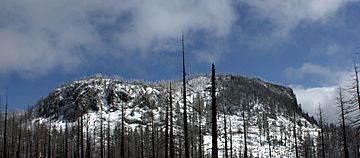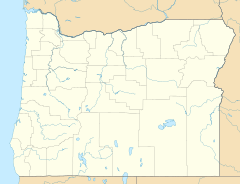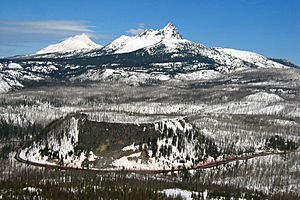Hogg Rock facts for kids
Quick facts for kids Hogg Rock |
|
|---|---|
 |
|
| Highest point | |
| Elevation | 4,823 feet (1,470 m) |
| Geography | |
| Location | Linn County, Oregon, U.S. |
| Parent range | Cascades |
| Topo map | USGS Three Fingered Jack |
| Geology | |
| Age of rock | About 80,000 years |
| Mountain type | Tuya |
| Climbing | |
| Easiest route | Hike |
Hogg Rock is a special type of `volcano` called a `tuya` and a `lava dome`. It is found in the `Cascade Range` in northern `Oregon`, close to `Santiam Pass`. This mountain was formed from a type of molten rock called `andesite` magma. It has very steep sides and thick, `glassy` edges.
Hogg Rock is about 80,000 years old. It sits south of `Three Fingered Jack` and north of `Hayrick Butte`. A tuya is a volcano that forms when lava erupts under a `glacier` or `ice sheet`. The lava melts through the ice and then spreads out, creating a flat top with steep walls. Hogg Rock is also a historic place. You can still see parts of Colonel `T. Egenton Hogg`'s old `Oregon Pacific Railroad` here. The mountain is a great spot for `snowshoeing and `snowmobile riding. From its top, you can see other volcanoes like `Black Butte`, `Mount Washington`, and Three Fingered Jack.
Contents
Where is Hogg Rock?
Hogg Rock is located in `Linn County`, in the U.S. state of `Oregon`. It is very close to `Santiam Pass`. This area is known for its volcanoes that formed with glaciers, like nearby `Hayrick Butte`.
The mountain is near the `Mount Jefferson Wilderness`. It's also where `Oregon Route 22` and `US Highway 20` cross the Cascade Range at Santiam Pass. Hogg Rock is right next to `Oregon Route 126`. The `United States Geological Survey` (USGS) considers Hogg Rock part of the Three Fingered Jack area. Hogg Rock is about 4,823 `4,823 feet (1,470 m)` tall.
Nature Around Hogg Rock
In the early 1990s, the `Oregon Department of Fish and Wildlife` looked for `peregrine falcon` nests at Hogg Rock. They thought it might be a place for them, but it didn't have many good ledges. Also, many people visit the area, which can disturb the birds.
You can find `wildflowers and `bracken ferns growing along the roads. The area has also been affected by forest fires in the past.
How Hogg Rock Formed
Hogg Rock is part of a chain of volcanoes between the `Three Sisters` and `Mount Jefferson`. The magma that formed Hogg Rock is called `andesite`. This type of lava is thicker than other kinds.
Hogg Rock is a `tuya` volcano. This means it has a flat top, which is typical for tuyas. It is also considered a small `lava dome`. Unlike most lava domes in the Cascades, which are made of `dacite` or `rhyodacite`, Hogg Rock is made of `andesite` lava. Its sides are very steep and have `glassy` edges that are about `3.3 to 19.7 feet (1 to 6 m)` thick.
Glaciers have worn down the volcano over time. Scientists believe Hogg Rock formed during the `Pleistocene` epoch. It is estimated to be about 80,000 years old.
Hogg Rock's Human Story
Hogg Rock was an important landmark for early travelers looking for Hogg Pass. This pass was later renamed Santiam Pass in 1929. The name Santiam comes from the `Santiam people`, a Native American tribe.
Hogg Rock was named after Colonel `T. Egenton Hogg`. He was in charge of the `Oregon Pacific Railroad`. This railroad was supposed to cross the Cascade Mountains right here. Construction started in the 1870s and cost a lot of money. Hogg wanted the railway to go all the way from `Yaquina Bay` to the `Snake River`.
The railroad was built by Chinese and Italian workers. It was meant to connect `Newport` and `Boise`. However, it only reached `Idanha`. Hogg ran out of money. To try and get land grants from the government, he built 11 `11 miles (18 km)` of tracks around Hogg Rock. He then had a small crew pull a boxcar on these isolated tracks. He claimed this was a train railway crossing the Cascades. Hogg went bankrupt in 1890. Later, the railroad was taken over by the `Southern Pacific Transportation Company`. Today, you can still see parts of the old railroad at Hogg Rock.
Santiam Pass, at an elevation of `4,817 feet (1,468 m)`, is a historic spot. West of Mount Washington and Three Fingered Jack, there are three main routes. One goes north and west along the `North Santiam River`, following Hogg's railroad path. Another goes southwest along the `McKenzie River`. The third route goes west over Tombstone Pass to the `South Santiam River`. This last path was used by the Santiam Wagon Road from 1865 to 1914.
Besides the railroad, there is also a quarry at Hogg Rock. You can also see the old, rotting Santiam Pass Ski Lodge building. The lodge was built in 1939–1940 by the `Civilian Conservation Corps`. It was a ski lodge for 46 years and later a youth camp. It closed in 1986. The lodge has survived big forest fires in 1968 and 2003. In the 2003 fire, firefighters wrapped it in `kevlar` sheets to protect it from the flames. In 2018, a group called "Friends of Santiam Pass Ski Lodge" got a permit to restore the lodge. They plan to make it a day lodge and rental place again.
Fun Things to Do
The `Hoodoo ski area` is located on nearby Hoodoo Butte. You can reach Hogg Rock by a `snowshoe` trail. This trail starts at the Santiam Pass Sno-Park. The Sno-Park has restrooms and a snow play area for kids. You need a permit to enter the Sno-Park.
There is also a `snowmobile` trail. It goes west from Santiam Lodge and then north at Hogg Rock. This trail follows parts of Hogg's old railroad. It eventually reaches the top of Hogg Rock. From the peak, you can see amazing views of `Black Butte`, Mount Washington, Hoodoo Butte, Sand Mountain, Three Fingered Jack, and Potato Hill. There's also a viewpoint on the western side of Hogg Rock. From there, you can see the forests on Potato Hill and Hoodoo Butte, as well as the Hoodoo Ski Area.
See also
 In Spanish: Hogg Rock para niños
In Spanish: Hogg Rock para niños



